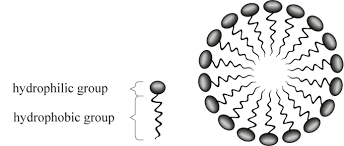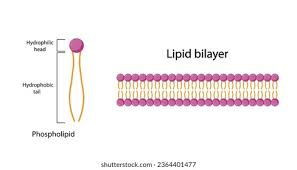Chapter 3.2: The structure of a cell Membrane
1/53
There's no tags or description
Looks like no tags are added yet.
Name | Mastery | Learn | Test | Matching | Spaced |
|---|
No study sessions yet.
54 Terms
Are all cells defined by membranes?
Yes (even prokaryotes and eukaryotes)
Membrane function
Physically separates cell from external environment and define spaces within many cells to help cells to carry out their functions
What are the main components of the cell membrane?
Lipids
Why are the properties of lipids important?
lipids have properties that allow them to form a barrier in an aqueous environment
What else (other than lipids) makes up the membrane?
proteins, carbohydrates
How many layers in a lipid are composed in a cell membrane
2
What is the major type of lipid found in the cell membrane
phospholipid
Amphipathic
Molecules with both hydrophilic and hydrophobic regions in a single molecule
Which phosphate group is hydrophilic?
The head
Which phosphate group is hydrophobic?
The tail
Why is the phosphate group hydrophilic?
The head group is polar and can form hydrogen bonds with water
Why are the two fatty acid tails hydrophobic
It is nonpolar and do not form hydrogen bonds with water
How do amphipathic molecules behave in water?
They spontaneously arrange themselves into various structures so the polar head groups are on the outside interact with water and the nonpolar tails come together on the inside, away from the water
What is the result of the amphipathic molecules arrangement in water?
Polar molecules exclude nonpolar molecules or nonpolar groups of molecules
What determines the shape of phospholipids?
The bulkiness of the head group relative to the hydrophobic tails
Micelles
Lipids with bulky heads and a single hydrophobic tail are wedge-shaped and pack into spherical structures

Lipids with less bulky head groups and TWO hydrophobic tails are roughly rectangular form what?
Bilayer

What is a lipid bilayer
A structure formed of two layers of lipids in which the hydrophilic heads are the outside surfaces of the bilayer and the hydrophobic tails are sandwiched in between, isolated from the aqueous environment.
How do liposomes form?
When phospholipids are in a aqueous environment with a pH of 7
They spontaneously form spherical bilayers
Why are bilayers effective in the cell membrane?
small tears in the membrane heal quickly because lipids spontenously rearrange themselves and surround the damage region because of the tendency of water to exclude nonpolar molecules
Why is a neutral pH important for liposome formation?
It keeps the phospholipid head groups ionized (charged) and hydrophilic.
What can liposomes capture during formation?
Macromolecules present in the surrounding solution.
How might liposome formation be linked to the origin of life?
Liposomes could form, break, and re-form in early Earth environments (like tidal flats), capturing nucleic acids and other molecules, aiding in the development of primitive cells.
How could early membranes evolve to control molecular traffic?
Through changes in their chemical composition, making them more or less permeable.
How did lipid synthesis eventually become protein-mediated?
Proteins began guiding lipid synthesis within the cell, although the exact mechanism of this transition is still unknown.
What does François Jacob's quote about evolution suggest about membrane evolution?
Evolution modifies existing systems (like membranes) rather than creating them from scratch.
Why are cell membranes considered dynamic?
Because lipids can move laterally, rotate, and flex due to weak van der Waals interactions.
How fast can a phospholipid move across a bacterial cell membrane?
In less than 1 second.
What is membrane fluidity and what factors affect it?
The ability of lipids to move within the membrane plane. Affected by fatty acid tail length and the number of carbon–carbon double bonds.
How does tail length affect membrane fluidity?
Longer tails reduce fluidity due to more van der Waals interactions.
How do carbon–carbon double bonds affect membrane fluidity?
More double bonds (unsaturated fats) increase fluidity by introducing kinks that reduce tight packing.
How do saturated vs. unsaturated fatty acids differ in membrane fluidity?
Saturated fatty acids are straight and tightly packed (less fluid); unsaturated fatty acids are kinked and loosely packed (more fluid).
Besides phospholipids, what other lipid is a major component of animal cell membranes?
Cholesterol — it makes up about 30% by mass of membrane lipids.
Is cholesterol amphipathic? If so, what are its hydrophilic and hydrophobic parts?
Yes. Hydrophilic part = hydroxyl group (–OH); Hydrophobic part = four carbon rings + hydrocarbon chain.
How does cholesterol insert itself into the lipid bilayer?
The hydroxyl group interacts with phospholipid head groups, while the ring structure interacts with fatty acid tails via van der Waals forces.
How does cholesterol affect membrane fluidity at high temperatures?
It decreases fluidity by stabilizing the membrane and reducing phospholipid movement.
How does cholesterol affect membrane fluidity at low temperatures?
It increases fluidity by preventing phospholipids from packing tightly.
Why is cholesterol important for maintaining membrane stability?
It buffers against temperature changes, maintaining consistent fluidity.
What are lipid rafts?
Defined patches in the membrane where specific lipids (e.g., sphingolipids), cholesterol, and proteins cluster.
What is lipid flip-flop, and why is it rare?
It's the spontaneous movement of lipids between bilayer layers; rare because the hydrophilic head must pass through the hydrophobic interior.
What does the rarity of lipid flip-flop allow?
Different lipid compositions between the inner and outer layers of the bilayer.
What percentage of red blood cell membrane mass is made of proteins?
About 50%.
What are four main functions of membrane proteins?
Transporters, receptors, enzymes, anchors.
What are integral membrane proteins?
Proteins permanently embedded in the membrane; cannot be removed without destroying the membrane.
What are peripheral membrane proteins?
Proteins temporarily attached to the membrane or integral proteins via weak noncovalent interactions.
What are transmembrane proteins?
A type of integral protein that spans the entire membrane, with hydrophilic ends and a hydrophobic midsection.
What role do peripheral membrane proteins play in signaling?
They help transmit external signals to the cell interior.
How do peripheral proteins help in lipid rafts?
They assist in clustering transmembrane proteins within lipid rafts.
What experimental technique shows that proteins move in the membrane?
Fluorescence Recovery After Photobleaching (FRAP).
How does FRAP demonstrate protein movement?
A bleached area regains fluorescence over time as unbleached proteins move into the area.
What does the result of a FRAP experiment indicate?
Membrane proteins can move laterally within the lipid bilayer.
What is the fluid mosaic model?
A model proposed by Singer & Nicolson in 1972 that describes the membrane as a fluid, dynamic bilayer of lipids, proteins, and carbohydrates.
What are the key features of the fluid mosaic model?
Lateral movement (fluidity) and diversity of molecules (mosaic).